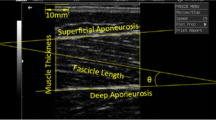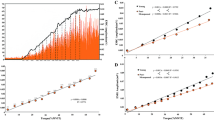Abstract
Muscle unloading results in decreased strength. This is partly attributed to reduced neural activation. This study examined whether men and women experienced different adaptations to muscle unloading. Ten men (21.4 ± 0.8 years; mean ± SE) and ten women (20.9 ± 0.2 years) were subjected to 1 week of muscle unloading. Muscle function was quantified during knee extensions before, and following unloading. Electromyography (EMG) was assessed during maximal isometric contractions before, and after unloading. Results showed greater (P < 0.05) unloading-induced decrement in muscle performance in women than men. The loss of peak torque was significantly correlated (r = 0.69) with the decline in EMG consequent to unloading, and women displayed significantly larger reductions in EMG. These findings indicate that: (1) women are more affected by muscle unloading than men, and (2) gender-related differences in strength declines are associated with similar disparities in the nervous system’s capacity to maximally stimulate muscle.
Similar content being viewed by others
References
Abt JP, Sell TC, Laudner KG, McCrory JL, Loucks TL, Berga SL, Lephart SM (2007) Neuromuscular and biomechanical characteristics do not vary across menstrual cycle. Knee Surg Sports Traumatol Arthrosc 15:901–907. doi:10.1007/s00167-007-0302-3
Adams GR, Caiozzo VJ, Baldwin KM (2003) Skeletal muscle unweighting: spaceflight and ground-based models. J Appl Physiol 95:2185–2201
Arafah BM (2006) Hypothalamic pituitary adrenal function during critical illness: limitations of current assessment methods. J Clin Endocrinol Metab 91:3725–3745. doi:10.1210/jc.2006-0674
Berg HE, Dudley GA, Haggmark T, Ohlsen H, Tesch PA (1991) Effects of lower limb unloading on skeletal muscle mass and function in humans. J Appl Physiol 70:1882–1885. doi:10.1063/1.349490
Charkoudian N, Joyner MJ (2004) Physiologic considerations for exercise performance in women. Clin Chest Med 25:247–255. doi:10.1016/j.ccm.2004.01.001
Clark BC, Collier SR, Manini TM, Ploutz-Snyder LL (2005) Sex differences in muscle fatigability and activation patterns of human quadriceps femoris. Eur J Appl Physiol 94:196–206. doi:10.1007/s00421-004-1293-0
Daida H, Allison TG, Squires RW, Miller TD, Gau GT (1996) Peak exercise blood pressure stratified by age and gender in apparently healthy subjects. Mayo Clin Proc 71:445–452
de Boar MD, Morse CI, Thom JM A, de Haan A, Narici MV (2007) Changes in antagonist muscles’ coactivation in response to strength training in older women. J Gerontol A Biol Sci Med 62:1022–1027
Deschenes MR, Giles JA, McCoy RW, Volek JS, Gomez AL, Kraemer WJ (2002) Neural factors account for strength decrements observed after short-term muscle unloading. Am J Physiol 282:R578–R583
Deschenes MR, Hillard MN, Wilson JA, Dubina MI, Eason MK (2006) Effects of gender on physiological responses during submaximal exercise and recovery. Med Sci Sports Exerc 38:1304–1310. doi:10.1249/01.mss.0000227316.93351.56
Deschenes MR, Holdren AN, McCoy RW (2008) Adaptations to short-term muscle unloading in young and aged men. Med Sci Sports Exerc 40:856–863. doi:10.1249/MSS.0b013e318164f4b6
Dudley GA, Duvoisin MR, Adams GR, Meyer RA, Below AH, Buchanan P (1992) Adaptations to unilateral lower limb suspension in humans. Aviat Space Environ Med 63:678–683
Friden C, Hirschberg AL, Saartok T (2003) Muscle strength and endurance do not significantly vary across 3 phases of the menstrual cycle in moderately active premenopausal women. Clin J Sport Med 13:238–241. doi:10.1097/00042752-200307000-00007
Frye AJ, Kamon E (1983) Sweating efficiency in acclimated men and women exercising humid and dry heat. J Appl Physiol 54:972–977
Fulco CS, Rock PB, Muza SR, Lammi E, Cymerman A, Butterfield G, Moore LG, Braun B, Lewis SF (1999) Slower fatigue and faster recovery of the adductor pollicis muscle in women matched for strength with men. Acta Physiol Scand 167:233–239. doi:10.1046/j.1365-201x.1999.00613.x
Fulco CS, Rock PB, Muza SR, Lammi E, Braun B, Cymerman A, Moore LG, Lewis SF (2001) Gender alters impact of hypobaric hypoxia on adductor pollicis muscle performance. J Appl Physiol 91:100–108
Hakkinen K, Pakarinen A (1995) Acute hormonal responses to heavy resistance exercise in men and women at different ages. Int J Sports Med 16:507–513. doi:10.1055/s-2007-973045
Hakkinen K, Kallinen M, Izquierdo M, Jokelainen K, Lassila H, Malkia E, Kraemer WJ, Newton RU, Alen M (1998) Changes in agonist-antagonist EMG, muscle CSA, and force during strength training in middle-aged and older people. J Appl Physiol 84:1341–1349
Hakkinen K, Pakarinen A, Kraemer WJ, Hakkinen A, Valkeinen H, Alen M (2001) Selective muscle hypertrophy, changes in EMG and force, and serum hormones during strength training in older women. J Appl Physiol 91:569–580
Harms CA (2006) Does gender affect pulmonary function and exercise capacity? Respir Physiol Neurobiol 151:124–131. doi:10.1016/j.resp.2005.10.010
Hasselgren PO (1999) Glucocorticoids and muscle catabolism. Curr Opin Clin Nutr Metab Care 2:201–205. doi:10.1097/00075197-199905000-00002
Hather BM, Adams GR, Tesch PA, Dudley GA (1992) Skeletal muscle responses to lower limb suspension in humans. J Appl Physiol 72:1493–1498
Hicks AL, Kent-Braun J, Ditor DS (2001) Sex differences in human skeletal muscle fatigue. Exerc Sport Sci Rev 29:109–112. doi:10.1097/00003677-200107000-00004
Holtermann A, Roeleveld K, Vereijken B, Ettema G (2005) Changes in agonist EMG activation level during MVC cannot explain early strength improvement. Eur J Appl Physiol 94:593–601. doi:10.1007/s00421-005-1365-9
Horton TJ, Pagliassotti MJ, Hobbs K, Hill JO (1998) Fuel metabolism in men and women during and after long-duration exercise. J Appl Physiol 85:1823–1832
Janse de Jonge XA, Boot CR, Thom JM, Ruell PA, Thompson MW (2001) The influence of menstrual cycle phase on skeletal muscle contractile characteristics in humans. J Physiol 530:161–166. doi:10.1111/j.1469-7793.2001.0161m.x
Kamen G, Caldwell GE (1996) Physiology and interpretation of the electromyogram. J Clin Neurophysiol 13:366–384. doi:10.1097/00004691-199609000-00002
Kent-Braun JA, Ng AV, Doyle JW, Towse TF (2002) Human skeletal muscle responses vary with age and gender during fatigue due to incremental isometric exercise. J Appl Physiol 93:1813–1823
Kohl HW, Blair SN, Paffenbarger RS, Macera CA, Kronenfeld JJ (1997) The aerobic center longitudinal study physical activity questionnaire. Med Sci Sports Exerc 29(Suppl. 6):S10–S14
Lemmer JT, Hurlbut DE, Martel GF, Tracy BL, Ivey FM, Metter EJ, Fozard JL, Fleg JL, Hurley BF (2000) Age and gender responses to strength training and detraining. Med Sci Sports Exerc 32:1505–1512. doi:10.1097/00005768-200008000-00021
Melanson EL, Sharp TA, Seagle HM, Horton TJ, Donahoo WT, Grunwald GK, Hamilton JT, Hill JO (2002) Effect of exercise intensity on 24-h energy expenditure and nutrient oxidation. J Appl Physiol 92:1045–1052
Mikines KJ, Richter EA, Dela F, Galbo H (1991) Seven days of bed rest decrease insulin action on glucose uptake in leg and whole body. J Appl Physiol 70:1245–1254
Ogawa T, Spina RJ, Martin WH 3rd, Kohrt WM, Schechtman KB, Holloszy JO, Ehsani AA (1992) Effects of aging, sex, and physical training on cardiovascular responses to exercise. Circulation 86:494–503
Richter EA, Kiens B, Mizuno M, Strange S (1989) Insulin action in human thighs after one-legged immobilization. J Appl Physiol 67:19–23
Roth SM, Ivey FM, Martel GF, Lemmer JT, Hurlbut DE, Siegel EL, Metter EJ, Fleg JL, Fozard JL, Kostek MC, Wernick DM, Hurley BF (2001) Muscle size responses to strength training in young and older men and women. J Am Geriatr Soc 49:1428–1433. doi:10.1046/j.1532-5415.2001.4911233.x
Russ DW, Kent-Braun JA (2003) Sex differences in human skeletal muscle fatigue are eliminated under ischemic conditions. J Appl Physiol 94:2414–2422
Russ DW, Lanza IR, Rothman D, Kent-Braun JA (2005) Sex differences in glycolysis during brief, intense isometric contractions. Muscle Nerve 32:647–655. doi:10.1002/mus.20396
Schulze K, Gallagher P, Trappe S (2002) Resistance training preserves skeletal muscle function during unloading in humans. Med Sci Sports Exerc 34:303–313. doi:10.1097/00005768-200202000-00019
Semmler JG, Kutzcher DV, Enoka RM (1999) Gender differences in the fatigability of human skeletal muscle. J Neurophysiol 82:3590–3593
Shephard RJ (2000) Exercise and training in women, part I: influence of gender on exercise and training responses. Can J Appl Physiol 25:19–34
Simoneau E, Martin A, Porter MM, Van Hoecke J (2006) Strength training in old age: adaptation of antagonist muscles at the ankle joint. Muscle Nerve 33:546–555. doi:10.1002/mus.20492
Staron RS, Karapondo DL, Kraemer WJ, Fry AC, Gordon SE, Falkel JE, Hagerman FC, Hikida RS (1994) Skeletal muscle adaptations during early phase of heavy-resistance training in men and women. J Appl Physiol 76:1247–1255
Staron RS, Hagerman FC, Hikida RS, Murray TF, Hostler DP, Crill MT, Ragg KE, Toma K (2000) Fiber type composition of the vastus lateralis muscle of young men and women. J Histochem Cytochem 48:623–629
Tarnopolsky MA, Ruby BC (2001) Sex differences in carbohydrate metabolism. Curr Opin Clin Nutr Metab Care 4:521–526. doi:10.1097/00075197-200111000-00010
Widrick JJ, Trappe SW, Romatowski JG, Riley DA, Costill DL, Fitts RH (2002) Unilateral lower limb suspension does not mimic bed rest or spaceflight effects on human muscle fiber function. J Appl Physiol 93:354–360
Wilmore JH, Stanforth PR, Gagnon J, Rice T, Mandel S, Leon AS, Rao DC, Skinner JS, Bouchard C (2001) Heart rate and blood pressure changes with endurance training: the HERITAGE family study. Med Sci Sports Exerc 33:107–116. doi:10.1097/00005768-200101000-00017
Wiswell RA, Jaque SV, Marcell TJ, Hawkins SA, Tarpenning KM, Constantino N, Hyslop DM (2000) Maximal aerobic power, lactate threshold, and running performance in master athletes. Med Sci Sports Exerc 32:1165–1170. doi:10.1097/00005768-200006000-00021
Yasuda N, Glover EI, Phillips SM, Isfort RJ, Tarnopolsky MA (2005) Sex-based differences in skeletal muscle function and morphology with short-term limb immobilization. J Appl Physiol 99:1085–1092. doi:10.1152/japplphysiol.00247.2005
Acknowledgments
This work was supported by grants from The Jeffress Memorial Trust, and The Borgenicht Program for Aging Studies and Exercise Science.
Author information
Authors and Affiliations
Corresponding author
Rights and permissions
About this article
Cite this article
Deschenes, M.R., McCoy, R.W., Holdren, A.N. et al. Gender influences neuromuscular adaptations to muscle unloading. Eur J Appl Physiol 105, 889–897 (2009). https://doi.org/10.1007/s00421-008-0974-5
Accepted:
Published:
Issue Date:
DOI: https://doi.org/10.1007/s00421-008-0974-5




